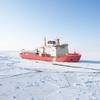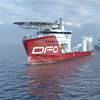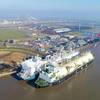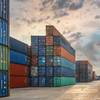LNG Carrier Seri Camar Delivered to MISC
Malaysian shipping firm MISC Group has taken delivery of Seri Cemara, the final vessel in a series of five MOSS-Type liquefied natural gas (LNG) carriers built for long-term charter to Petronas.
The 150,200 CBM LNG carrier has been built for MISC by South Korean shipbuilder Hyundai Heavy Industries Co., Ltd. (HHI). Upon its delivery, Seri Cemara joins her sister MOSS-Type carriers Seri Camellia, Seri Cenderawasih, Seri Cempaka and Seri Camar on long-term charter to Petronas.
The new generation of Seri C Class LNG carriers have been designed for worldwide trading capability to enable them to call at all major LNG terminals in the world as well as loading capability at floating LNG (FLNG) units. Seri Camellia, MISC's first MOSS-Type vessel made history in 2017 as the first in the world to have operational experience with Petronas FLNG Satu.
The naming ceremony was attended by Petronas President & Group CEO, Tan Sri Wan Zulkiflee Wan Ariffin, and his wife Puan Sri Dr. Azura Ahmad Tajuddin, who is the Lady Sponsor to the vessel, at the HHI Shipyard in Ulsan, South Korea.
Tan Sri Wan Zulkiflee said, "Petronas is committed to deliver safe and reliable supply of energy. It is therefore of utmost importance that we have access to the most reliable, safe and operationally efficient fleet of LNG carriers to serve the needs of our customers worldwide. The Seri Cemara and its four sister vessels cement the long-standing synergy between MISC and Petronas' LNG business, anchored upon the spirit of collaboration and shared success within the Petronas Group."
The naming and delivery ceremony was also attended by Dato' Ab. Halim Mohyiddin, MISC's Chairman, Yee Yang Chien, MISC's President/Group CEO, H.D. Shin, Senior Executive Vice President & Chief Operating Officer of Hyundai Heavy Industries Co., Ltd. (HHI) as well as management and representatives from Petronas, MISC and HHI.
Speaking at the ceremony, Chairman of MISC Dato' Ab Halim said the vessel, along with her sister ships, is a reflection of the principles that MISC stands by - strong, capable and dynamic.
"The new generation of carriers is highly significant for MISC as we forge ahead in fulfilling our vision to consistently provide better energy-related maritime solutions and services. This project is especially meaningful as it represents our commitment to exceed the expectation of our customers, conducting our business in a responsible and sustainable manner, as well as in ensuring optimum value creation over time. She is fortified to meet the challenges that lie ahead, and, along with the rest of the Seri C vessels, will support MISC's continuous journey towards sustainable LNG shipping."
Yee Yang Chien, President/Group CEO of MISC, said MISC and Petronas have a partnership that dates back some 35 years, to the days when MISC first entered the LNG shipping segment.
"In the intervening years, both businesses have matured and grown to meet the world's rapidly changing energy needs. Together, we have achieved several important firsts – the development and shipment from Petronas' Floating LNG unit through to the design and delivery of this innovative MOSS-Type Seri C Class LNG carrier. Today marks another important milestone, as we continue our work together," he added.
Unlike other LNG carriers, the MOSS Type vessels have been built with an Integrated Hull Structure (IHS), whereby a continuous cover encloses and shields four separate spherical tanks. The IHS provides additional protection for the temperature-sensitive cargoes as well as a more robust and superior cargo containment system, ensuring a higher degree of operational flexibility for MISC to operate in harsh meteorological conditions.
Each of the LNG carriers complied with and will carry ECO Notation in recognition of their environmental credentials. The MOSS-Type vessels have been specifically designed to minimize hull resistance, increase propulsion efficiency, reduce power requirements, and lower CO2 emissions.
The vessels are installed with pre-swirl duct and Propeller Boss Cap Fin (PBCF) that are able to provide around 4 percent energy savings at design draft, along with an X-twister rudder for improved maneuvering performance.
Other green technology features of the vessel include the installation of the Selective Catalytic Reduction (SCR) system for the diesel generator to comply with the latest IMO Tier III requirement and the Ozone Ballast Water Treatment System. The vessels will be powered by an Ultra Steam Turbine (UST) plant.
The vessels can operate on extended low-load gas mode, meaning that they can operate entirely on LNG for full compliance with existing and impending Sulphur Emissions Control Area (SECA) regulations. The delivery of Seri Cemara brings the current number of MISC's LNG fleet to 29 vessels, further strengthening MISC's position as a leading owner and operator of LNG vessels.












